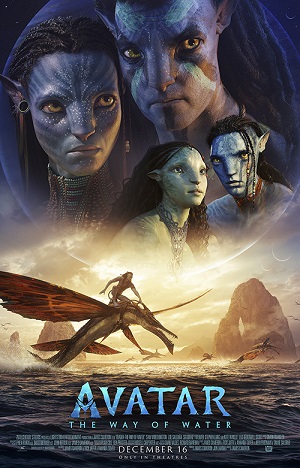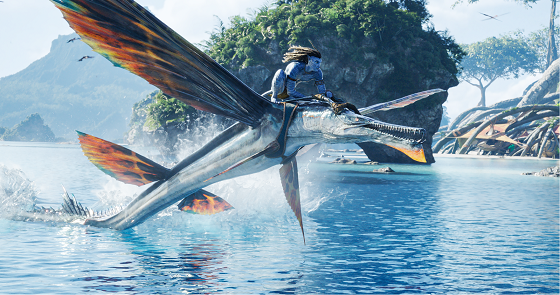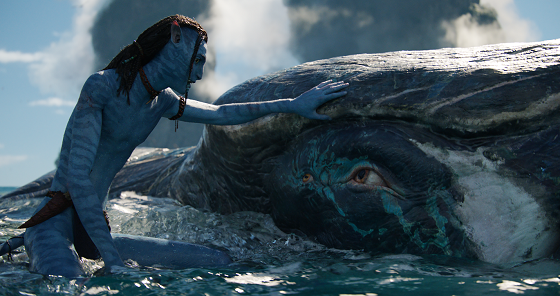

[Rating: Rock Fist Way Up]
In theaters Friday, Dec. 16
Holy crap: he actually did it. James Cameron, cinema’s unrivaled action maestro, has emerged after roughly a dozen years in the mines and handed over a flat-out masterpiece. Once again revolutionizing VFX and mo-cap work in service to a grand, pulse-pounding vision, Cameron’s Avatar: The Way of Water (WoW) is the rare sequel that laps its predecessor, nailing every aspect of the effort from characters to visuals to story.
WoW kicks off with Jake Sully (Sam Worthington) getting the audience all caught up on what’s been going on since the end of the last installment, when he joined forces with his alien in-laws to drive the resource-greedy humans off Pandora. In the dozen-plus intervening years, Jake and Neytiri (Zoe Saldana) have had two boys and a girl, and also adopted the miracle baby (now young woman), Kiri, that came out of the comatose avatar of Dr. Grace (Sigourney Weaver, playing both parts). Jake and Neytiri have also semi-adopted an abandoned human baby (now young man), Spider (Jack Champion), and live in relative peace and happiness until the return of the “sky people.”
More destructive than ever and determined to root out and kill Jake as the leader of the resistance, the humans have also uploaded the saved memories of the last film’s big bad, Colonel Quaritch (Stephen Lang), into a Na’vi Avatar. Quaritch leads his resurrected squad of ultimate bad-asses back into the bush to root out Jake and the resistance, which puts enough of a pinch on the soldier-turned-revolutionary that he flees with his family to an entirely different part of the planet. This self-imposed exile leads Jake and co. to the water-based Metkayina clan led by married chiefs Tonowari (Cliff Curtis) and Ronal (Kate Winslet), who take pity on the family out of respect for their struggles against the invaders.

This change in setting doesn’t just allow for the mechanics of the plot to unfold, though: it opens up the world of Pandora and expands on the established mythology of the Na’vi and their connection to the living world surrounding them. Just as the first movie emphasized the bond Neytiri and her people had to the forest, so too does this one take the time to establish the deep attachment between the Metkayina and the marine ecosystem they inhabit. Far from just empty world-building, these moments add texture and layers to not just the characters, but the struggle that will define the back half of WoW.
And good golly, is there ever struggle. Several independent side-plots operate in conjunction with the main conflict between Jake and Quaritch, all of which serve to raise the stakes as WoW barrels in for its action-packed landing. Never afraid to go right for the throat, Cameron is constantly putting vulnerable kids and creatures into harm’s way, cashing in the credits built up throughout the first and second half that encourage audience buy-in for these people. It’s a sneaky trick, but one that works magnificently throughout the movie, and elevates what might have been an hour of punch-porn a-la the current Marvel model.
That was never gonna happen here, though. Cameron stands in exclusive company when it comes to directors that can stage and shoot action, with only Spielberg as a rival. A thirteen-year layoff between installments seems like a lot of time until the movie’s complex, multi-character, multi-location chase/fight vignettes wallpaper you into the back of your goddamned seat. Cameron’s ability to connect the three-dimensional space of his world with the very grounded and deliberate mapping of his action set-pieces is nothing short of miraculous, and justifies the time this production spent making sure the VFX, frame rates, and blocking all complement each other.

And while the second act does sag a bit, the dividends these slower, emotional moments bear via the heightened stakes later on make a good argument for this one’s 192-minute runtime. No one makes an audience hate someone or something more than James Cameron, whether it’s a slimy company man looking to make a buck, a liquid metal assassin, or planet-raping invaders: yet no one rewards their audience more richly when killing the shit out of these same pricks, either. As is often the case with the director’s movies, there’s plenty of suffering along the way, plenty of hurt, yet the action is the salve, the balm: that which makes the movie and the audience whole by the end.
Between that, the staggering visuals, and a surprisingly competent narrative with rich characterization and real stakes, what we’ve got here is the best action blockbuster since Fury Road. Cameron’s complete mastery of the action form combined with his virtual reinvention of the mo-cap format put WoW on a whole other level. The movie doesn’t have any right being this good, what with the pedestrian script of its predecessor, the seeming irrelevance of this IP more than a decade later, wacky plot contrivances that bring familiar faces back, and the self-serious tone it maintains throughout, yet it is, man. It really, actually, surprisingly is that good.
Or maybe it isn’t, and this reviewer was just taken in by the breathtaking visuals and master-class action filmmaking. One thing is for sure, though: this reviewer will be going back a second time to make sure, and maybe (just maybe) get blown away all over again.





Comments on this entry are closed.